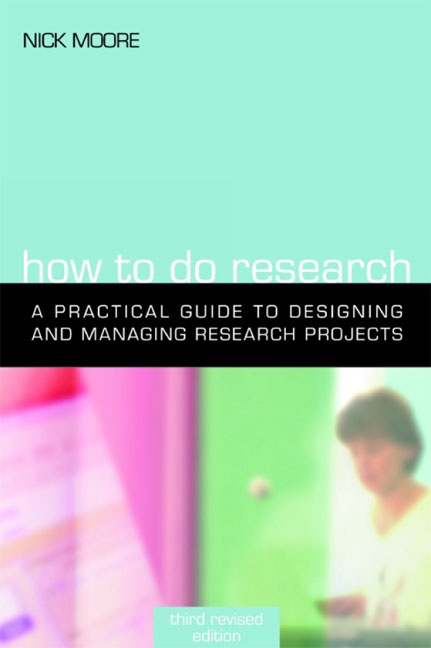Book contents
- Frontmatter
- Contents
- Acknowledgements
- Introduction: Types of research
- Part 1 The research process
- 1 Develop the research objectives
- 2 Design and plan the study
- 3 Write the proposal
- 4 Obtain financial support for the research
- 5 Manage the research
- 6 Draw conclusions and make recommendations
- 7 Write the report
- 8 Disseminate the results
- Part 2 Methods
- Appendix The market for information professionals: A proposal from the Policy Studies Institute
- Index
5 - Manage the research
from Part 1 - The research process
Published online by Cambridge University Press: 09 June 2018
- Frontmatter
- Contents
- Acknowledgements
- Introduction: Types of research
- Part 1 The research process
- 1 Develop the research objectives
- 2 Design and plan the study
- 3 Write the proposal
- 4 Obtain financial support for the research
- 5 Manage the research
- 6 Draw conclusions and make recommendations
- 7 Write the report
- 8 Disseminate the results
- Part 2 Methods
- Appendix The market for information professionals: A proposal from the Policy Studies Institute
- Index
Summary
The big moment has arrived. After all your careful planning and preparation, you have received approval for the work or the funder has agreed to make the money available. Now you have to get the project on the road and, somehow, keep it going in the right direction.
The project plan
The first thing you should do is to turn the information that is contained in the proposal into a project plan – a document that will set out what you are going to have to do between now and the end of the research.
If you have a well worked-out proposal, this stage is not difficult. If you have been set a firm deadline by which time the project must be completed, then work backwards from this. You know how much time you planned to spend on different tasks, so you can now actually set dates for their start and completion. Now that you are working with actual dates, as distinct from notional weeks or months, you can begin to make allowances for things like public holidays – if your project runs over the winter, you will probably need, for example, to allow at least two weeks for the Christmas period.
If you do not have a fixed deadline, you can begin from now and work forward. You may not be able to start immediately. You may have to recruit staff, or to wait for them to finish work on other projects. It is, however, well worth fixing an actual start date as soon as you can and then to work towards it. Then pace things out from there. Remember to make allowance for things like the time needed to complete and return questionnaires. Check also that you are not committing yourself and the project staff to more days in a month than can be achieved.
Work out the critical path for the project, if you have not already done so for the proposal. This involves looking at each of the tasks and seeing whether they can be carried out concurrently or whether one needs to follow on from the other. This can be important if you are using sub-contractors – they will need to know when they can get started.
Information
- Type
- Chapter
- Information
- How to Do ResearchA practical guide to designing and managing research projects, pp. 58 - 71Publisher: FacetPrint publication year: 2006
